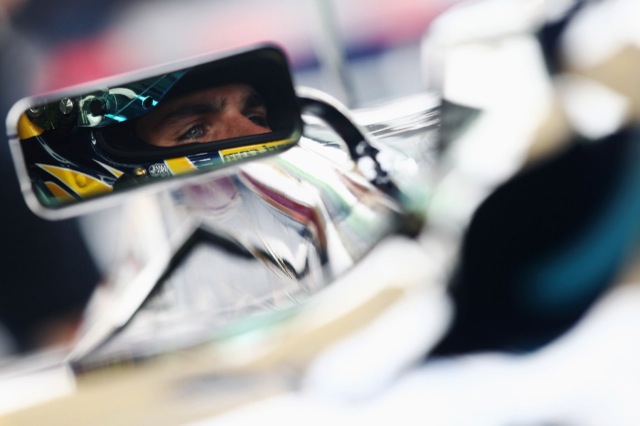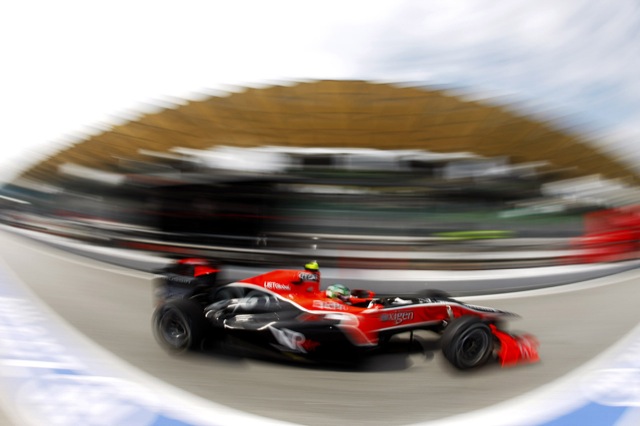Formula One, and motor sport in general, is a male-dominated industry. From the sport’s beginnings through to the present day, there have been very few female racers, and while America is seeing some success with Danica Patrick and Katherine Legge, Formula One hasn’t seen a woman compete since 1992. Instead of going into why this is, or what could be done about it, I’m going to praise those who have participated, perhaps against the odds, in motor sport’s pinnacle series.
Maria Teresa de Filippis
As you will see from the following names in this post, the majority of female racers in F1 came from Italy. I really have no idea why this is, but I thought it was worth a mention before I begin.
The first lady to compete with the men was Maria Teresa de Filippis, born in 1926 and heralding from Naples, Italy. Maria debuted in 1958 at the relatively late age of 31 driving a Maserati 250F at Monaco. de Filippis failed to qualify for her first race, but returned later in the season for the Belgian Grand Prix held at Spa Francorchamps. This race was to be the highlight for Maria, managing to finish in tenth place from nineteenth on the grid.
A race in Portugal saw Maria drive for Scuderia Centro Sud using the same chassis and engine, but being the first of the retirees saw an early end for her race. The 1958 Italian Grand Prix wasn’t a complete disaster for de Filippis, and although she ended up retiring with just 13 laps to run, Maria was officially classified as eighth, such were the number of retirements at Monza that year. Not a bad result for grid slot of 21st. Maria returned in 1959 in a Behra Porsche, but after failing to qualify at the season opener in Monaco, decided to call it a day.
Following a lot of deaths in the sport, particularly that of Jean Behra, whose team Maria joined in early 1959, de Filippis bowed out of the sport. The following year in 1960 she got married and started a family. Maria is still involved in motor sport though, currently vice-president for the International Club of Former F1 Grand Prix Drivers, a post she accepted in 1997 and an organisation Maria has been involved with since 1979.
Lella Lombardi
Next up is arguably the most successful female racer to compete in Formula One, Maria Grazia Lombardi, or Lella. Hailing from Alessandria in Italy, Lella competed the ’74, ’75 and ’76 seasons and a total of 17 races.
After enjoying some success in lower formulae, Lella entered the 1974 British Grand Prix in a privately funded Brabham. However, Lombardi failed to qualify, but did attract the eye of March, a team partly founded by none other than Max Mosley. In 1975, Lombardi drove at the third meeting in South Africa in a March 741, and then each race up until the 14th round in a March 751. It was this season that saw the most success for Lella, most notably in Spain when Lombardi become the first woman to score a world championship point. Well, almost. On lap 25 an accident involving Rolf Stommelen’s Lola tragically killed four people. The race continued for another four laps before being stopped. As the race only ran for half its intended laps, only half-points were awarded. Thus, Lombardi scored 0.5 points; a great achievement clouded in sadness.
In 1976, Lella competed in a further four races, but with little more success, decided to call it a day and retired from Formula One after competing in the Austrian Grand Prix. She raced in sports cars for a while, even enjoying some success with Osella sports cars and Alfa Romeo touring cars. However, Lella was diagnosed with cancer and unfortunately passed away in 1992.
Divina Galica
Divina Galica was the first British female to make an attempt at participation in a grand prix. Born in Hertfordshire in 1944, Divina was better known for her Olympic career, taking part in the Innsbruck games in 1964 in the downhill skiing and slalom events. Galica also competed in the Grenoble and Sapporo winter games and even held the downhill speed record for a while, topping out at 125mph.
However, after a chance invitation to a celebrity motor race, Divina became hooked on four-wheels and started to compete in karts, sports cars and trucks before making her debut in Formula One in 1976. Racing in a non-works Surtees, Divina attempted to qualify for the British Grand Prix. However, along with Lella Lombardi, couldn’t manage it and was forced to sit out. This was the only race in the sport’s history where two woman attempted to compete in the same grand prix.
Two seasons later Divina returned in a non-works Hesketh. She turned up at the first two races of the year in Argentina and Brazil. However, as before and due to a poor performing car, she failed to qualify for both. Following this she retired from Formula One driving and competed in other motor sports. It wasn’t long before Galica chose a life of business over racing and eventually took up the vice-president role for Skip Barber Racing. And then in 2005, Galica resigned to work for iRacing as the director of the company. iRacing are focused on developing life-like racing simulations to help drivers hone their skills.
Desiré Wilson
It wasn’t until 1980 that Formula One saw a woman compete again, this time it was South African born Desiré Wilson. Desiré entered herself into the British Grand Prix in a Brands Hatch Racing prepared Williams FW07 – she failed to qualify. The second time Wilson competed was in 1981 at the South African non-championship event, lasting until lap 51 before retiring (both race and F1 career).
Although giving up on Formula One, Desiré did compete in the British Aurora F1 Series, a formula made up of old F1 cars and up-and-coming drivers. The series didn’t last long, much like the recent Grand Prix Masters series, however, Desiré did win the Brands Hatch event.
Giovanna Amati
Giovanna is the most recent female to race a Formula One car. Although Katherine Legge has tested a Minardi as recent as 2005, the British star of Champ Car didn’t race the machine. Thus, 1992 stands as the last time a woman competed in F1. Born in Rome, Italy in 1962, Giovanna had an interesting childhood, having been kidnapped and held to ransom to her wealthy parents. Amati’s interest in motor sports started early when she bought a motor cycle at the age of fifteen. The bug didn’t cease and by 1981 Giovanna was competing successfully in Formula Abarth before progressing to Italian Formula three in 1985, and Formula 3000 in ’87.
Giovanna landed herself a test in a Benetton Formula One car, but this was perhaps helped by her partner at the time, Benetton team chief Flavio Briatore. Not getting the drive, Amati persisted and in 1992 she managed to get a drive in a Brabham. However, the under-funded team had barely changed the car since the year previous and despite trying three times, Amati couldn’t qualify the terrible car. After the Brazilian Grand Prix she was dropped in favour of Damon Hill.
A short diversion into sports cars that led to some success came before commentary and column-writing in Giovanna’s native Italian.
Wrap Up
So there we are, the only five woman to have competed in Formula One. I find it sad that only a handful of ladies have attempted F1, and looking at the success of Patrick and Legge in America, one has to wonder why the series struggles with the opposite sex. Setting up a satellite series is probably out of the question due to the massive costs involved, but as shown in Champ Cars, a separate series isn’t necessary. What is necessary are young woman getting involved in motor sport at a young age, being encouraged and coached with equal status to their male counterparts and looked upon by team owners and influential figures without prejudice.
External Links & Recommended Reading:


















Well I appreciate her. I have heard someone mentioned at milionairematch.com, which was the woman would do twice as much as the men do to go half the work. So she is so special, she is the first lady to compete with the men
This is a brilliant article, Ollie – I learned a lot about women in F1. I’ve been looking forward to it since you mentioned you’d be doing something on the subject at the start of October.
Thanks Alianora. I’m considering tackling the whys of it all next, but that may not happen until November.
It’s all about upper body strength.
Same as Danica And Legge, I believe there is a lady racing in American series thatd eserved a mention (even though this was an F1 article)
Her name is Milka Duno, and as Divina she participated in an invitational for Porsche owners in Venezuela.
Milka surprised everybody with her driving skills and immediately was offered a drive in Vzla’s GT championship…
From there she took off to Porsche Supercup, Ferrari Challenge 355, Panoz GT series, barber Dodge Pro series, American Le Mans Series, American rolex series, etc…
This year she is a rookie in IndyCar series…
PS. She has a BS in engineering and 4 master degrees!
Wow, great information Luis, thanks.
I didn’t even know you could downhill ski at 125 mph. Go, Davina! I’m always a sucker for fast women on wheels…(okay, or snow too). 🙂
I’m not sure which would be scarier – racing a car at 200mph or skidding over snow at 125mph. The current record is 156mph!
[…] October I posted about the history of the fairer sex in Formula One. It wasn’t a long post though, there have only been five ladies to have competed alongside […]
[…] feel it will be a while before W Series get to boast of the first female competitor in Formula One since Giovanna Amati in […]
[…] One doesn’t discriminate against women, they are allowed to enter the championship and a few have done over the sport’s lengthening history. But in order to get there, you have to be on the right […]